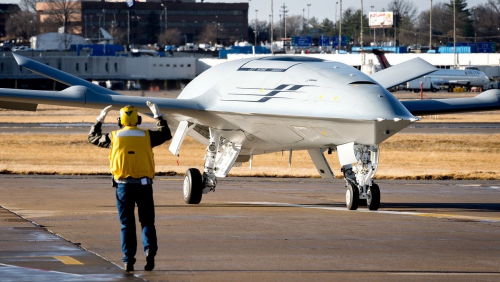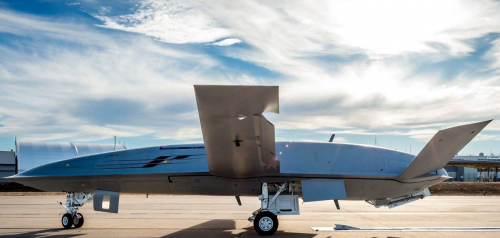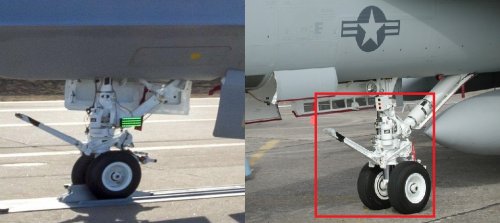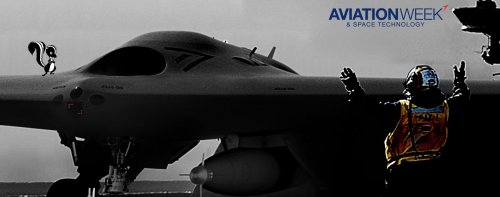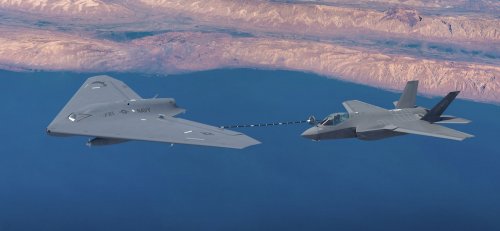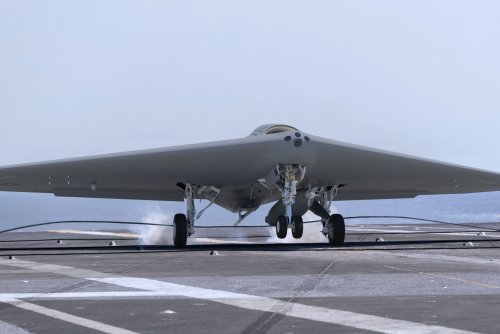You are using an out of date browser. It may not display this or other websites correctly.
You should upgrade or use an alternative browser.
You should upgrade or use an alternative browser.
US Navy’s UCLASS / CBARS / MQ-XX / MQ-25 Stingray Program
- Thread starter fightingirish
- Start date
- Joined
- 3 June 2011
- Messages
- 18,328
- Reaction score
- 12,199
Dragon029 said:New photos:
Note in particular how the seams of the ailerons are blended - flexible / morphing skin, or just a flexible seal strip?
Looks like the same things the F-22 and F-35 use.
- Joined
- 3 June 2006
- Messages
- 3,094
- Reaction score
- 3,953
Source at Twitter: https://twitter.com/defense_news/status/973525458317991936Dragon029 said:New photos:
[...]
In a few days Ms Valerie Insinna will published an article at Defence News.
Twitter: https://twitter.com/ValerieInsinna/status/973531239817859072Go read James' story, then head to @defense_news in a couple days and read mine. We have different takes! For now enjoy pretty drone photos.
- Joined
- 6 August 2007
- Messages
- 3,888
- Reaction score
- 5,918
Flyaway said:I wonder if NG are still cranking out RQ-180s or if not many were built.
There has been nothing to substantiate that any were ever built or that there was ever any such program.
- Joined
- 21 January 2015
- Messages
- 12,134
- Reaction score
- 16,295
quellish said:Flyaway said:I wonder if NG are still cranking out RQ-180s or if not many were built.
There has been nothing to substantiate that any were ever built or that there was ever any such program.
Yes there was being as an Air Force senior member actually referred to in a talk some years back.
https://www.secretprojects.co.uk/forum/index.php/topic,20900.msg223807.html#msg223807
marauder2048
"I should really just relax"
- Joined
- 19 November 2013
- Messages
- 3,157
- Reaction score
- 926
Flyaway said:quellish said:Flyaway said:I wonder if NG are still cranking out RQ-180s or if not many were built.
There has been nothing to substantiate that any were ever built or that there was ever any such program.
Yes there was being as an Air Force senior member actually referred to in a talk some years back.
https://www.secretprojects.co.uk/forum/index.php/topic,20900.msg223807.html#msg223807
It wasn't in the talk; it was an inference made by the journalist.
The sum total of actual evidence for it is zero.
- Joined
- 3 June 2006
- Messages
- 3,094
- Reaction score
- 3,953
Next week we will know more from 'Aviation Leak'.
Enter the Aquarium: On Monday, March 26, @AviationWeek will exclusively reveal @LockheedMartin Skunk Works’ MQ-25 proposal for the @USNavy’s Stingray competition. Rob Weiss: "We're going out strong, we’re going out confident, and we’re playing to win." @SeaAirSpace #SAS2018 Link: https://t.co/X5BBBTNv4P
Attachments
- Joined
- 24 November 2008
- Messages
- 1,549
- Reaction score
- 2,606
flanker said:The others were posted in high res, but here is the missing one in high res too.
Thx for the pic... It seems that part of the nose gear comes from the Super Hornet.
Attachments
- Joined
- 3 June 2011
- Messages
- 18,328
- Reaction score
- 12,199
fightingirish said:Next week we will know more from 'Aviation Leak'.
Aviation Leak & Space Mythology.
- Joined
- 3 June 2006
- Messages
- 3,094
- Reaction score
- 3,953
In Memory of Ben Rich (1925 - 1995)sferrin said:Aviation Leak & Space Mythology.fightingirish said:Next week we will know more from 'Aviation Leak'.
- Joined
- 21 January 2015
- Messages
- 12,134
- Reaction score
- 16,295
https://twitter.com/JamesDrewNews/status/976820811729424384?s=20
Are you ready for the ray? Next week, @AviationWeek exclusively reveals the @LockheedMartin Skunk Works design for the @USNavy MQ-25 Stingray program. Rob Weiss: “We have the technologies well in hand.” Coming March 26 to (link: http://aviationweek.com) aviationweek.com #SAS2018 @SeaAirSpace
- Joined
- 3 June 2006
- Messages
- 3,094
- Reaction score
- 3,953
- Joined
- 27 April 2008
- Messages
- 406
- Reaction score
- 133
bring_it_on
I really should change my personal text
- Joined
- 4 July 2013
- Messages
- 3,651
- Reaction score
- 3,781
litzj
BLOG : http://jaesan-aero.blogspot.com/
BWB type wing-fuselage design with one engine can be noticed. Asymmetric layout of aerial re-fuel tank can be specified.
At the nose, several sensors are located for (possibly) navigation, simple surveillance, or situation awareness while some antennas are located under the fuselage, and fuel tank is located beside of it.
Landing gears are well designed to secure space for additional payload on the wing, however, attachment of additional payload is uncertain. Inlet duct are not severely distorted, usual for stealth aircraft with loss of engine efficiency, to obtain better cruise efficiency with small loss of duct.
Compare to Boeing's design, it looks lack of canted VT and huge fuselage. It looks similar to the company's previous RQ-180 while Boeing made it looks like Tacit Blue (Although Tacit Blue was from NG)
At the nose, several sensors are located for (possibly) navigation, simple surveillance, or situation awareness while some antennas are located under the fuselage, and fuel tank is located beside of it.
Landing gears are well designed to secure space for additional payload on the wing, however, attachment of additional payload is uncertain. Inlet duct are not severely distorted, usual for stealth aircraft with loss of engine efficiency, to obtain better cruise efficiency with small loss of duct.
Compare to Boeing's design, it looks lack of canted VT and huge fuselage. It looks similar to the company's previous RQ-180 while Boeing made it looks like Tacit Blue (Although Tacit Blue was from NG)
Dragon029
ACCESS: Top Secret
- Joined
- 17 March 2009
- Messages
- 881
- Reaction score
- 440
litzj said:BWB type wing-fuselage design with one engine can be noticed. Asymmetric layout of aerial re-fuel tank can be specified.
At the nose, several sensors are located for (possibly) navigation, simple surveillance, or situation awareness while some antennas are located under the fuselage, and fuel tank is located beside of it.
Landing gears are well designed to secure space for additional payload on the wing, however, attachment of additional payload is uncertain. Inlet duct are not severely distorted, usual for stealth aircraft with loss of engine efficiency, to obtain better cruise efficiency with small loss of duct.
Compare to Boeing's design, it looks lack of canted VT and huge fuselage. It looks similar to the company's previous RQ-180 while Boeing made it looks like Tacit Blue (Although Tacit Blue was from NG)
According to the Aviation Week article the nose sensors are cameras that allow ground operators (down below the deck, etc) to see the deck (see deck handlers, etc) with a similar or better field of view than a manned platform would have.
For payload the Lockheed design has 2 hardpoints; one for the Cobham AAR pod, another spare for future equipment such as podded radars or other ISR equipment.
- Joined
- 21 January 2015
- Messages
- 12,134
- Reaction score
- 16,295
Dragon029 said:litzj said:BWB type wing-fuselage design with one engine can be noticed. Asymmetric layout of aerial re-fuel tank can be specified.
At the nose, several sensors are located for (possibly) navigation, simple surveillance, or situation awareness while some antennas are located under the fuselage, and fuel tank is located beside of it.
Landing gears are well designed to secure space for additional payload on the wing, however, attachment of additional payload is uncertain. Inlet duct are not severely distorted, usual for stealth aircraft with loss of engine efficiency, to obtain better cruise efficiency with small loss of duct.
Compare to Boeing's design, it looks lack of canted VT and huge fuselage. It looks similar to the company's previous RQ-180 while Boeing made it looks like Tacit Blue (Although Tacit Blue was from NG)
According to the Aviation Week article the nose sensors are cameras that allow ground operators (down below the deck, etc) to see the deck (see deck handlers, etc) with a similar or better field of view than a manned platform would have.
For payload the Lockheed design has 2 hardpoints; one for the Cobham AAR pod, another spare for future equipment such as podded radars or other ISR equipment.
In spite of what LM are saying it doesn’t look like it would require much to be changed to a stealthy ISR role.
- Joined
- 24 November 2008
- Messages
- 1,549
- Reaction score
- 2,606
Mr London 24/7 said:http://aviationweek.com/site-files/aviationweek.com/files/uploads/2018/03/skunksting-2lockheedmartin.jpg
I'm a little bit disappointed, assuming it is a clean sheet design, tailored to the requirements of CBARS...Without stealth requirements I expected a more eye appealing design, with rounded contours/edges in resemblance of the famous Horten H IX.
bring_it_on
I really should change my personal text
- Joined
- 4 July 2013
- Messages
- 3,651
- Reaction score
- 3,781
I am beginning to believe that with the Navy having gone back and forth so many times on this Lockheed, and perhaps even Boeing decided to minimize IR&D and invest in modifying their original proposals which were for a multi-mission craft not as skewed towards the Refueling requirement.
- Joined
- 4 May 2008
- Messages
- 2,439
- Reaction score
- 762
Flyaway said:Interestingly LM are saying there is no stealth shaping in their design.
https://mobile.twitter.com/JamesDrewNews/status/978232561913737216
Sounds like BS to me. Who in their right mind designs a planform-aligned flying wing for a tanker mission if they see no benefit to LO.
More likely they started the design well before LO was de-emphasized. Maybe they're omitting the more cosmetic stealth treatments for now, but it's baked in.
Before someone comes out saying that flying wings have great L/D, please keep in mind that for endurance-type missions it's actually CL^3/2 /CD that matters. So being able to fly at high lift coefficient (which requires a tail) is what sizes the airplane.
litzj
BLOG : http://jaesan-aero.blogspot.com/
my typo error. not rq 180 but rq 170
litzj
BLOG : http://jaesan-aero.blogspot.com/
AeroFranz said:Flyaway said:Interestingly LM are saying there is no stealth shaping in their design.
https://mobile.twitter.com/JamesDrewNews/status/978232561913737216
Sounds like BS to me. Who in their right mind designs a planform-aligned flying wing for a tanker mission if they see no benefit to LO.
More likely they started the design well before LO was de-emphasized. Maybe they're omitting the more cosmetic stealth treatments for now, but it's baked in.
Before someone comes out saying that flying wings have great L/D, please keep in mind that for endurance-type missions it's actually CL^3/2 /CD that matters. So being able to fly at high lift coefficient (which requires a tail) is what sizes the airplane.
we should remind that it is naval aircraft. Span of aircraft cannot be as long as ground borne aircraft.
some compromise should done for panform design.
anyway endurance is proportional to L/D while range is proportional to L^3/2 /D as you said
- Joined
- 21 January 2015
- Messages
- 12,134
- Reaction score
- 16,295
sferrin said:Granted these are just CGI but it doesn't appear to have a folding wing.
I wonder if any of this UAV actually physically exists or is all just vapourware?
aero-engineer
ACCESS: Restricted
- Joined
- 9 July 2007
- Messages
- 49
- Reaction score
- 6
sferrin said:Granted these are just CGI but it doesn't appear to have a folding wing.
Look at the top view again coming off the cat. Only the outer 1/3 folds.
- Joined
- 31 December 2006
- Messages
- 802
- Reaction score
- 363
Flyaway said:I wonder if any of this UAV actually physically exists or is all just vapourware?
Per the AWST article, these are CGI. Lockheed didn't want to start fabricating a prototype until the requirements were finalized.
- Joined
- 16 April 2008
- Messages
- 9,601
- Reaction score
- 14,474
AeroFranz said:Flyaway said:Interestingly LM are saying there is no stealth shaping in their design.
https://mobile.twitter.com/JamesDrewNews/status/978232561913737216
Sounds like BS to me. Who in their right mind designs a planform-aligned flying wing for a tanker mission if they see no benefit to LO.
More likely they started the design well before LO was de-emphasized. Maybe they're omitting the more cosmetic stealth treatments for now, but it's baked in.
It's not really planform edge aligned. The wingtips are clipped on lines that don't seem to align with any other edges, and the strakes alongside the exhaust don't line up either. The inlet is a nice simple semicircle as well, and seems like a straight shot into the engine . If they "de-stealthed" an older design, they did more than just leave off coatings.
red admiral
ACCESS: Top Secret
- Joined
- 16 September 2006
- Messages
- 1,805
- Reaction score
- 2,374
Got to wonder whether they're just betting that the Navy changes their requirements again. Flying wing configuration just doesn't really make sense otherwise.
- Joined
- 4 May 2008
- Messages
- 2,439
- Reaction score
- 762
The other thing flying wings obviously don't have it's a vertical. You are stressing your flight controls quite a bit to achieve comparable handling qualities to a tailed carrier aircraft.
If I were the configurator on this aircraft (which i'm obviously not, so what do i know...), you'd have to have very convincing arguments to make me design a flying wing for this mission absent ANY LO requirement.
My humble opinion is that they started with LO and got rid of all the stuff they could without completely changing the design. Nozzles and inlets are a (comparatively) low hanging fruit. Same with coatings, doors serrated edges. You can do that and not throw away whatever aero database and controls work was already performed. They can certainly gain a lot of internal volume by getting rid of the serpentine duct and exhaust.
TomS made a valid argument about planform alignment. I don't know if you could start with it and then make local adjustments to get better internal arrangement around the fuselage area or lift distribution on the wing...seems like a lot of work.
If I were the configurator on this aircraft (which i'm obviously not, so what do i know...), you'd have to have very convincing arguments to make me design a flying wing for this mission absent ANY LO requirement.
My humble opinion is that they started with LO and got rid of all the stuff they could without completely changing the design. Nozzles and inlets are a (comparatively) low hanging fruit. Same with coatings, doors serrated edges. You can do that and not throw away whatever aero database and controls work was already performed. They can certainly gain a lot of internal volume by getting rid of the serpentine duct and exhaust.
TomS made a valid argument about planform alignment. I don't know if you could start with it and then make local adjustments to get better internal arrangement around the fuselage area or lift distribution on the wing...seems like a lot of work.
- Joined
- 21 January 2015
- Messages
- 12,134
- Reaction score
- 16,295
red admiral said:Got to wonder whether they're just betting that the Navy changes their requirements again. Flying wing configuration just doesn't really make sense otherwise.
Possibly. Not like the US Navy has shown the clearest direction of travel on what they want so far have they?
- Joined
- 9 November 2008
- Messages
- 1,070
- Reaction score
- 164
A flying wing holds a lot more fuel for the same deck spot than a traditional aircraft of the same spot size. They are also more fuel efficient so that they can use more of their internal fuel for AAR or achieve longer range in the ISR role.AeroFranz said:you'd have to have very convincing arguments to make me design a flying wing for this mission absent ANY LO requirement.
red admiral
ACCESS: Top Secret
- Joined
- 16 September 2006
- Messages
- 1,805
- Reaction score
- 2,374
SpudmanWP said:A flying wing holds a lot more fuel for the same deck spot than a traditional aircraft of the same spot size. They are also more fuel efficient so that they can use more of their internal fuel for AAR or achieve longer range in the ISR role.
Folding wings make the first point moot. Big fuselage more volumetricly efficient.
More efficient - not in practice. A nice high aspect ratio wing with high lift devices that you can trim with a tail seems a far better solution.
Now the lack of vertical stabilisers is really interesting. Very surprised they didn't buy their way on given the usual issues with control on approach and take-off
- Joined
- 9 November 2008
- Messages
- 1,070
- Reaction score
- 164
Only a small portion of the outer wing folds, so not much fuel capacity is lost.
Any way you slice it, a flying wing is more fuel efficient (more lift, less drag).
Check the X-47B carrier landings.
Any way you slice it, a flying wing is more fuel efficient (more lift, less drag).
Check the X-47B carrier landings.
- Joined
- 4 May 2008
- Messages
- 2,439
- Reaction score
- 762
It is a bit counterintuitive at first, but flying wings don't necessarily have higher L/D.
They can't trim high lift coefficients, so they tend to have lower wingloading/wing area to achieve the same takeoff and landing performance as a tailed aircraft.
That's extra skin friction drag that lowers the L/D. They also tend to have lower aspect ratio because of aeroelastic issues stemming from the first bending mode of the wing being close to the pitch/plunge mode of the fuselage. Get those two close together and you're in serious trouble, so typically flying wings are not given as much aspect ratio. To be fair, active controls go some way towards relieving the problem.
If you remove the LO designs, where everything is sacrificed to signature, there are hardly flying wings out there.
They can't trim high lift coefficients, so they tend to have lower wingloading/wing area to achieve the same takeoff and landing performance as a tailed aircraft.
That's extra skin friction drag that lowers the L/D. They also tend to have lower aspect ratio because of aeroelastic issues stemming from the first bending mode of the wing being close to the pitch/plunge mode of the fuselage. Get those two close together and you're in serious trouble, so typically flying wings are not given as much aspect ratio. To be fair, active controls go some way towards relieving the problem.
If you remove the LO designs, where everything is sacrificed to signature, there are hardly flying wings out there.
Actually, less l/D equates less down wash easing refueling OP... Espcially with a probe and drogue configuration  *
*
Otherwise Spudman said it all: bag more fuel for less deck space.
Don't forget also that this is a robot: the thing has to be stacked up for long before being used.
A drawback? Yes: trapping and go around sequence can be challenging with the inherent high drag of split flap system. But we will see what configuration they choose. Probably that other aero trick would be used.
Who knows?
Otherwise Spudman said it all: bag more fuel for less deck space.
Don't forget also that this is a robot: the thing has to be stacked up for long before being used.
A drawback? Yes: trapping and go around sequence can be challenging with the inherent high drag of split flap system. But we will see what configuration they choose. Probably that other aero trick would be used.
Who knows?
- Joined
- 1 April 2006
- Messages
- 11,375
- Reaction score
- 10,202
https://www.popularmechanics.com/military/aviation/a19600045/lockheed-martin-unveils-mq-25-stingray-tanker-drone-design-for-the-navy/
Thanks generous PopMech team for posting hi-res renderings
Thanks generous PopMech team for posting hi-res renderings
Attachments
Similar threads
-
Lockheed Martin - Multi purpose long endurance (MPLE) UAV
- Started by fightingirish
- Replies: 3
-
-
-
-
Optimized late 2020's USN (practical) Air Wing for CVN 68 & CVN 78 Class ships
- Started by Ironmiked
- Replies: 13

